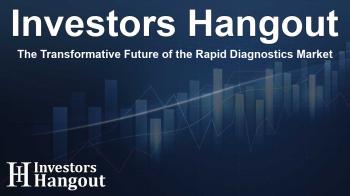The Transformative Future of the Rapid Diagnostics Market

The Transformative Future of the Rapid Diagnostics Market
The rapid diagnostics market is set to experience a remarkable transformation, expected to reach $24.28 billion by 2032, with a noteworthy compound annual growth rate (CAGR) of 6.6%. This growth is propelled by various factors including the increasing demand for point-of-care diagnostics and the rising prevalence of chronic and infectious diseases.
Drivers of Market Growth
This market's impressive growth is largely driven by the need for quick decision-making within healthcare settings. Healthcare providers are increasingly favoring rapid diagnostics to improve patient outcomes and streamline treatment processes. As technology advances, the integration of smartphone-based platforms for diagnostic purposes is also becoming more common, allowing for greater accessibility and efficiency in disease detection.
The industry is undergoing a significant shift, embracing automation and artificial intelligence to enhance diagnostic capabilities. Companies are innovating new diagnostic platforms and revising existing products to keep pace with the rapid advancements in technology and patient care needs.
Market Segmentation Insights
In terms of product types, the Kits segment is at the forefront, comprising approximately 67.6% of the market. This dominance is attributed to the frequent use of diagnostic kits in home and clinical settings for early detection and monitoring of diseases. As demand continues to rise, the Kits segment is expected to exhibit the highest CAGR of 7.2% throughout the forecast period.
Platform Performance
The Immunoassay platform leads the market with a substantial 54.2% share, which demonstrates a significant interest in these tests driven by the need for affordability and user-friendliness. Despite this, the Molecular Detection Tests segment is emerging rapidly, showcasing an impressive CAGR of 6.2%, thanks to increased sensitivity and accuracy.
Application Areas of Growth
Among various applications, the Infectious Diseases segment holds the largest market share, primarily due to the heightened focus on diagnostics following global pandemics. As awareness of early disease detection grows, investments in cancer biomarker research are set to elevate the Tumor/Cancer Markers Testing segment during the forecast period.
Strategic Market Opportunities
The rapid diagnostics market presents ample strategic opportunities, particularly through advancements in technology and emerging markets. There is a surge in demand for specialized solutions suited for home healthcare, illustrating the market's shift toward patient-centric care. Companies that successfully leverage automation and develop comprehensive diagnostic solutions will likely see substantial growth.
Global Market Dynamics
The North American region currently holds a substantial market share of approximately 41%, largely due to its sophisticated healthcare infrastructure and high testing rates. Meanwhile, the Asia-Pacific region is fast emerging as the quickest growing market, with a projected CAGR of 10.1%, fueled by a growing population and increased healthcare expenditures.
Competitive Landscape
The competitive environment in the rapid diagnostics field is robust, characterized by both established players and new entrants. Companies are actively forming strategic partnerships and pursuing innovation to enhance their service offerings. For instance, technology advancements in smartphone diagnostics and automated result interpretation are shaping this dynamic field. Leaders in the industry are striving not only to meet but also anticipate market demands as they broaden their technological capabilities.
Future Developments and Challenges
As we look to the future, the rapid diagnostics sector will continue to face challenges such as regulatory hurdles, the necessity for maintaining high standards of diagnostic accuracy, and addressing cost considerations. However, opportunities abound for companies willing to innovate in mobile health solutions and expand into underserved markets.
Market growth will likely accelerate as organizations effectively address these challenges while tapping into new technologies that improve healthcare delivery. The drive towards optimizing patient management through advanced diagnostics will prevent roadblocks and ensure that the sector meets the demands of both clinicians and patients alike.
Frequently Asked Questions
What is the expected growth of the rapid diagnostics market?
The rapid diagnostics market is projected to reach $24.28 billion by 2032, growing at a CAGR of 6.6%.
Which segment is leading in the rapid diagnostics market?
The Kits segment dominates the market with approximately 67.6% market share due to its widespread adoption.
What technological advancements are influencing the market?
Automation, AI integration, and smartphone platform technologies are significantly driving innovation in the rapid diagnostics market.
How is the market expanding regionally?
North America holds the largest market share while Asia-Pacific is the fastest-growing region due to increased healthcare investments.
What challenges does the rapid diagnostics market face?
The market encounters challenges like regulatory compliance and maintaining diagnostic accuracy amid growing cost pressures.
About The Author
Contact Caleb Price privately here. Or send an email with ATTN: Caleb Price as the subject to contact@investorshangout.com.
About Investors Hangout
Investors Hangout is a leading online stock forum for financial discussion and learning, offering a wide range of free tools and resources. It draws in traders of all levels, who exchange market knowledge, investigate trading tactics, and keep an eye on industry developments in real time. Featuring financial articles, stock message boards, quotes, charts, company profiles, and live news updates. Through cooperative learning and a wealth of informational resources, it helps users from novices creating their first portfolios to experts honing their techniques. Join Investors Hangout today: https://investorshangout.com/
The content of this article is based on factual, publicly available information and does not represent legal, financial, or investment advice. Investors Hangout does not offer financial advice, and the author is not a licensed financial advisor. Consult a qualified advisor before making any financial or investment decisions based on this article. This article should not be considered advice to purchase, sell, or hold any securities or other investments. If any of the material provided here is inaccurate, please contact us for corrections.

